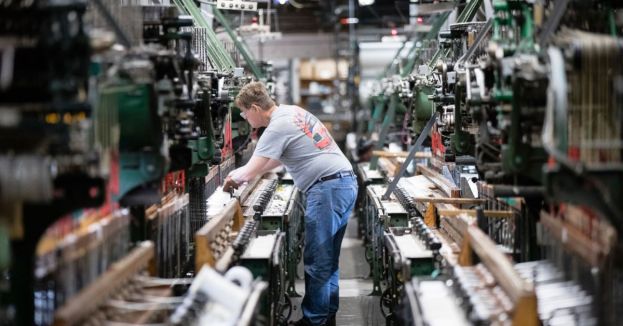A survey published Monday by the National Association for Business Economics shows that its members assume the economy to grow 5.6% this year – down distinctly from their previous estimate of 6.5%. The respondents projected the economy will grow by 3.5% in 2022.
"NABE Outlook survey panelists have moderated their expectations about the prospects for economic growth in 2021 since May," said David Altig, president-elect of the NABE and the director of research at the Federal Reserve Bank of Atlanta.
WATCH: RUBIO TALKS ABOUT BIDEN'S WEAPONIZED JUSTICE SYSTEM![]()
The economists are frequently becoming more pessimistic about the growth outlook: More than half of respondents – 58% – said perils to the economy are skewed to the downside, compared to just 15% in May. Only 16% of respondents said the risks to the outlook are skewed to the upside, down strikingly from 56% in May.
WATCH: TRUMP CAMPAIGN SUING NEVADA![]()
Pandemic-related concerns proceed to manage the list of potential risks: Nearly two-thirds of the economists said they saw the emergence of vaccine-resistant variants of COVID-19 as the most significant threat, while 9% identified slowing vaccine uptake.
BIG STAGE MOVE: RFK JR. CHALLENGES TRUMP TO DEBATE, WILL HE ACCEPT?![]()
Another 9% said they were worried about the possibility of a "large fiscal program" as Democrats craft a huge $3.5 trillion spending bill, while 5% of respondents said the greatest downside opportunity is financial policy inaction or gridlock.
NEW RECORD: ASTONISHING AMOUNT POURED INTO 2024 KENTUCKY DERBY BETS![]()
On the flip side, about 44% of respondents identified a faster vaccine rollout as the biggest upside risk to the economy, followed by an infrastructure spending package (14%) and stronger global growth (12%).
HOW DEEP DOES THE RABBIT HOLE GO? BOEING EMPLOYEES ACCUSED OF FALSIFYING RECORDS![]()
Other specialists have also discredited their forecasts as the U.S. dealt with a wave of COVID-19 cases, driven largely by the spread of the highly contagious delta variant. The OECD on Tuesday forecast that U.S. GDP would grow 6% in 2021. That's down nearly 1 percentage point from May when the Paris-based organization foretold GDP would rise 6.9% this year.
PRO-PALESTINE ACTIVIST GROUP CLAIMS RESPONSIBILITY FOR TORCHING POLICE VEHICLES IN PORTLAND![]()
While the U.S. was making solid progress with vaccinations — 76.5% of adults have received at least one shot, according to the Centers for Disease Control and Prevention — and infections began falling, cases rebounded over the summer.
CONSERVATIVE FEDERAL JUDGES LAY IT OUT FLAT FOR COLUMBIA PROTESTORS![]()
The U.S. is averaging about 140,000 new COVID-19 cases per day with roughly 1,000 deaths, according to CDC data.
HE SAID, SHE SAID: NATHAN WADE RECOUNTS 'LOVE AFFAIR' WITH FANI WILLIS![]()
Although breakthrough infections in vaccinated people happen, they tend to be far less serious.
THE IRONY OF JUSTICE: NY SENATOR CHALLENGES LAW HE ENDORSED AMIDST RAPE ALLEGATIONS![]()
FedEx's labor shortage is having dire consequences along the company's supply chain.
A lack of truck drivers, package handlers and other workers are resulting in longer delivery times and higher costs for American companies who are then raising prices on U.S. consumers.
REP. GAETZ'S REQUEST TO INTERVIEW 'NOTORIOUS' POLITICAL PRISONER DENIED![]()
Constrained labor markets are causing "widespread inefficiencies in our operations," said FedEx Chief Operating Officer Rajesh Subramaniam, who saw worker shortages had a $450 million influence on the company’s quarterly results.







 Discover alternative ideas that will make you think
Discover alternative ideas that will make you think Engage in mind bending debate
Engage in mind bending debate Earn points, rise in rank, have fun
Earn points, rise in rank, have fun


